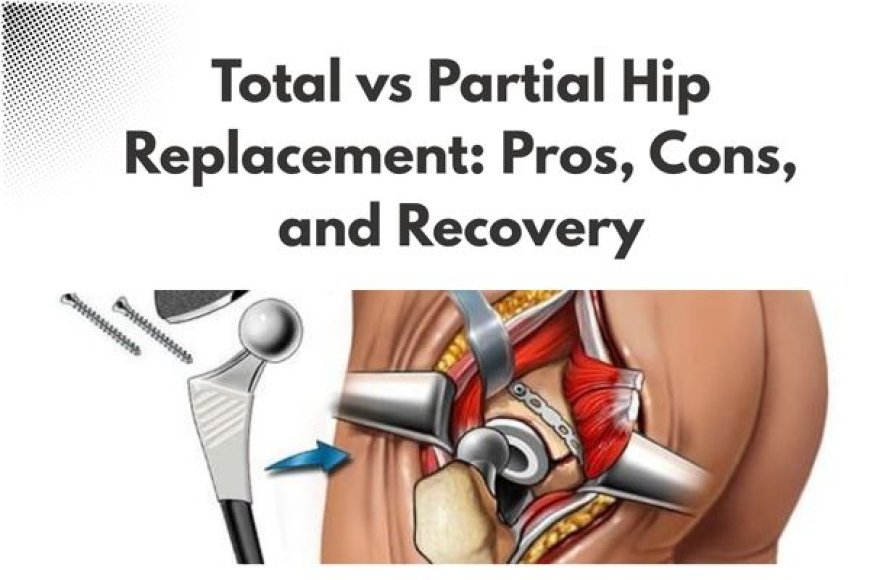Total vs Partial Hip Replacement: Pros, Cons, and Recovery
Discover the key differences between total and partial hip replacement, including their pros, cons, recovery time, and when each is recommended. Make informed decisions for better joint health.

A hip replacement also known as hip joint arthroplasty, a surgical procedure for those patients suffering from hip joint. It is replaced with an artificial implant which is made of plastic and metals. This procedure is only done when an individuals pain crosses the limits and other treatments don't work.
In this blog, we will explain the difference between partial hip replacement vs total hip replacement. Also, we will talk about the pros and cons of hip replacement.
What is Partial Hip Replacement?
Partial Hip Replacement focused on the partial which means half of the damaged part of the hip will be replaced only. This procedure is done when the ball which is( the head of the femur) of the joint. When this ball of the joint is damaged but the acetabulum(socket) is still working(healthy). Surgeons decide to use a metal ball and metal stem to connect to the thigh bone. This procedure is called partial hip replacement.
What is Total Hip Replacement?
Total Hip Replacement also known as Total hip arthroplasty, could be a strategy that can be utilized to treat specific hip issues such as a broken hip, advanced joint pain, or other types of harm to the hip joint. In this operation, parts of the hip joint (the femoral head or ball of the joint and the socket, or acetabulum) are removed and replaced with an artificial joint made of metal, plastic or ceramic.
The point of surgery is to diminish the pain, and enhance the work and restore the mobility of the joint. Total hip replacement is generally suggested after other treatments such as medicines, physical treatment, and changes in activity level have not driven to alter.
Pros & Cons of Partial & Total Hip Replacement
Here are the pros and cos of Partial Hip Replacement and Total Hip Replacement
Pros and Cons of Partial Hip Replacement
The pros of partial Hip Replacement surgery are described below:
-
Less surgery time: A partial hip replacement can take less time in the surgery room. It may decrease the various potential risks of prolonged exposure to anesthesia.
-
Quicker Recovery: The quickest recovery you can have than a total hip replacement.
-
Less Risk: During partial hip replacement patients experience a reduction in pain and blood loss.
-
Minimally Invasive: There is less bone resected than total hip replacement.
The cons of partial Hip Replacement surgery are described below:
-
Limited Use Cases: This doesnt work for all patients, Partial hip replacement is typically performed for specific types of fractures (like a broken femoral neck) but this is generally not a good fitting surgery for arthritis or more generalized joint disease.
-
Risk of Needing a Full Replacement Later: Revision surgery may be possible, since only part of the hip is replaced, wear or breakdown of the natural socket (acetabulum) can cause pain and the need for a full hip replacement.
Pros & Cons of Total Hip Replacement
Pros of Total Hip Replacement
-
Pain Relief: This procedure helps to relieve patients from highly hip joint pain. This is the greatest benefit for this process.
-
Improved Mobility: Patients often experience increased range of motion, enabling easier walking, climbing stairs, and other movements.
-
Enhanced Quality of Life: By alleviating pain and improving mobility, hip replacement can significantly enhance an individuals overall quality of life, allowing them to participate in activities so they can enjoy.
-
High Success Rate: Hip replacement surgery has a high success rate in achieving pain relief and improved mobility.
Cons of Total Hip Replacement
-
Surgical risk: All surgery carries some risks such as infection, blood clots, nerve damage and problems with anesthesia.
-
Recovery time: It may take months to recover and a patient may need physical therapy or to follow a rehabilitation program.
-
Nerve injury: Nerves located near to the operated region that may be damaged, hence resulting in numbness, weakness or pain.
Risk and complications?
Most of the patients respond well to hip replacement surgery but sometimes this has risks and some complications are associated between partial hip replacement vs total hip replacement. The most common complications in both surgeries include infection, bleeding, blood clots, nerve damage, etc.
Before your surgery, you need to discuss all the important points with your surgeon. There is also a risk of damage to surrounding tissues or organs, depending on the location and complexity of the procedure. In some cases, patients may experience prolonged recovery times or persistent pain. Scarring, swelling, and limited mobility can also occur.
Hip replacement surgery can be a life-changing method for those patients who are suffering from chronic hip pain. It is vital to get the difference between partial hip replacement vs total hip replacement because it has benefits and risks. You ought to be examined along with your surgeon to decide which one is right for you.
How to decide which surgery is right for you?
Your surgeon will help you choose between a partial hip replacement vs total hip replacementbased on a few factors, including your age, general health, the condition of your hip bones, and your orthopedic surgeons preferences. You can discuss with your doctor, and if you have any doubts regarding these surgeries, you can directly ask them to understand the concept of each process.
The following factors also depend on which surgery is right for you:
-
Level of joint damage: If any individual suffers from arthritis and joint damage so the doctor prefers total hip replacement surgery otherwise if an individual suffers from fractures, the preferred partial hip replacement.
-
Age: Partial Hip Replacement is suitable for elderly patients who suffer from hip fractures, while Total Hip Replacement is suitable for younger patients.
-
Medical Opinion: Your surgeon provides you best guidance according to your overall health condition, age, and bone density, then they decide which surgery is suitable for you.
Conclusion
As we discussed above the difference between partial hip replacement surgery and total hip replacement surgery. These both are life changing or we can say that these surgeries give a new life to a person. It is a treatment which gives you pain free life.
Read the differences of these surgeries and take guidance from your surgeon before any surgeries start.

































